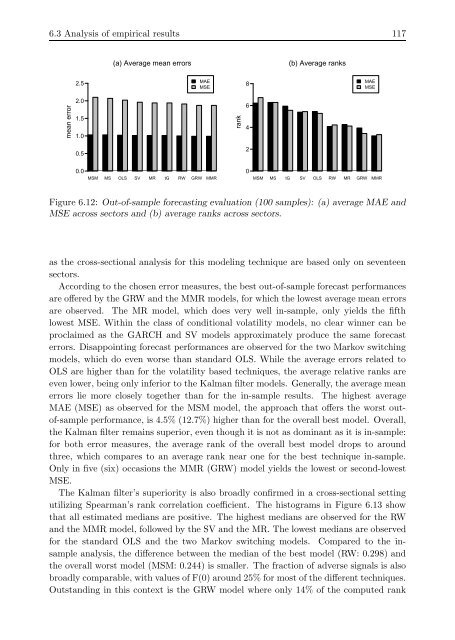Applications of state space models in finance
Applications of state space models in finance
Applications of state space models in finance
Create successful ePaper yourself
Turn your PDF publications into a flip-book with our unique Google optimized e-Paper software.
6.3 Analysis <strong>of</strong> empirical results 117<br />
mean error<br />
2.5<br />
2.0<br />
1.5<br />
1.0<br />
0.5<br />
(a) Average mean errors<br />
MAE<br />
MSE<br />
0.0<br />
MSM MS OLS SV MR tG RW GRW MMR<br />
rank<br />
8<br />
6<br />
4<br />
2<br />
(b) Average ranks<br />
MAE<br />
MSE<br />
0<br />
MSM MS tG SV OLS RW MR GRW MMR<br />
Figure 6.12: Out-<strong>of</strong>-sample forecast<strong>in</strong>g evaluation (100 samples): (a) average MAE and<br />
MSE across sectors and (b) average ranks across sectors.<br />
as the cross-sectional analysis for this model<strong>in</strong>g technique are based only on seventeen<br />
sectors.<br />
Accord<strong>in</strong>g to the chosen error measures, the best out-<strong>of</strong>-sample forecast performances<br />
are <strong>of</strong>fered by the GRW and the MMR <strong>models</strong>, for which the lowest average mean errors<br />
are observed. The MR model, which does very well <strong>in</strong>-sample, only yields the fifth<br />
lowest MSE. With<strong>in</strong> the class <strong>of</strong> conditional volatility <strong>models</strong>, no clear w<strong>in</strong>ner can be<br />
proclaimed as the GARCH and SV <strong>models</strong> approximately produce the same forecast<br />
errors. Disappo<strong>in</strong>t<strong>in</strong>g forecast performances are observed for the two Markov switch<strong>in</strong>g<br />
<strong>models</strong>, which do even worse than standard OLS. While the average errors related to<br />
OLS are higher than for the volatility based techniques, the average relative ranks are<br />
even lower, be<strong>in</strong>g only <strong>in</strong>ferior to the Kalman filter <strong>models</strong>. Generally, the average mean<br />
errors lie more closely together than for the <strong>in</strong>-sample results. The highest average<br />
MAE (MSE) as observed for the MSM model, the approach that <strong>of</strong>fers the worst out<strong>of</strong>-sample<br />
performance, is 4.5% (12.7%) higher than for the overall best model. Overall,<br />
the Kalman filter rema<strong>in</strong>s superior, even though it is not as dom<strong>in</strong>ant as it is <strong>in</strong>-sample:<br />
for both error measures, the average rank <strong>of</strong> the overall best model drops to around<br />
three, which compares to an average rank near one for the best technique <strong>in</strong>-sample.<br />
Only <strong>in</strong> five (six) occasions the MMR (GRW) model yields the lowest or second-lowest<br />
MSE.<br />
The Kalman filter’s superiority is also broadly confirmed <strong>in</strong> a cross-sectional sett<strong>in</strong>g<br />
utiliz<strong>in</strong>g Spearman’s rank correlation coefficient. The histograms <strong>in</strong> Figure 6.13 show<br />
that all estimated medians are positive. The highest medians are observed for the RW<br />
and the MMR model, followed by the SV and the MR. The lowest medians are observed<br />
for the standard OLS and the two Markov switch<strong>in</strong>g <strong>models</strong>. Compared to the <strong>in</strong>sample<br />
analysis, the difference between the median <strong>of</strong> the best model (RW: 0.298) and<br />
the overall worst model (MSM: 0.244) is smaller. The fraction <strong>of</strong> adverse signals is also<br />
broadly comparable, with values <strong>of</strong> F(0) around 25% for most <strong>of</strong> the different techniques.<br />
Outstand<strong>in</strong>g <strong>in</strong> this context is the GRW model where only 14% <strong>of</strong> the computed rank

















